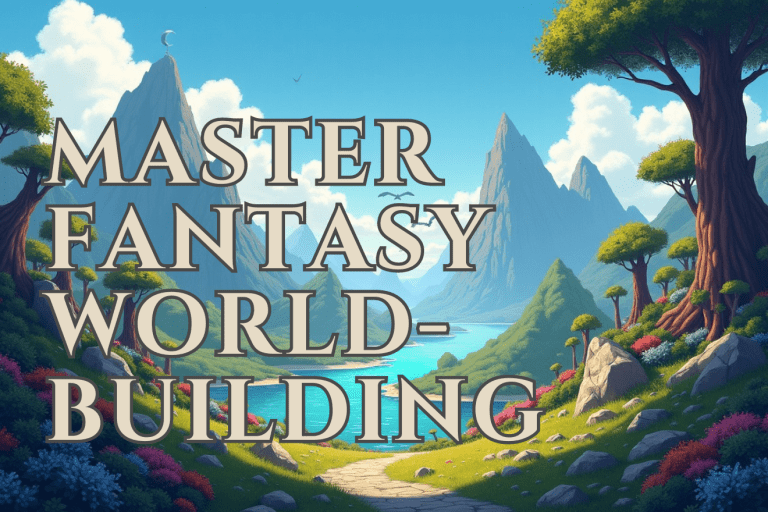How to Write a Novel: A Step-by-Step Guide for Beginners (2024)
Have you ever dreamed of writing your own novel but didn’t know where to start? You’re not alone! In fact, a recent survey found that 81% of Americans want to write a book, but only 2% actually do it. Well, guess what? 2024 is your year to join that exclusive club of authors! Whether you’re crafting a thrilling mystery or a heartwarming romance, this step-by-step guide will walk you through the novel-writing process. So grab your favorite pen (or keyboard), and let’s embark on this exciting literary adventure together!

1. Brainstorm Your Story Idea
The first step in writing a novel is coming up with a story idea that excites you. This is the seed from which your entire novel will grow. But where do you start?
- Explore Different Genres and Themes: Do you have a passion for science fiction, fantasy, or historical fiction? Perhaps you’re drawn to contemporary dramas or psychological thrillers. Take some time to explore different genres and think about the themes that resonate with you. What issues or ideas do you want to explore in your writing? Your story should be something that you’re passionate about.
- Use Writing Prompts to Spark Creativity: If you’re struggling to come up with ideas, writing prompts can be a great way to kickstart your creativity. Prompts are designed to push you out of your comfort zone and help you think in new ways. For example, you might try a prompt like, “Write about a character who discovers a secret door in their home.”
- Mind Map Potential Plot Points and Character Arcs: Once you have a general idea, start mapping out potential plot points and character arcs. A mind map can help you visually organize your thoughts and see how different elements of your story might connect. This process can also reveal any gaps in your story that you need to fill.
- Consider Your Target Audience and Market Trends: Finally, think about who you’re writing for. Are you targeting young adults, mystery lovers, or fantasy enthusiasts? Understanding your target audience can help you tailor your story to their preferences. It’s also a good idea to look at current market trends to see what’s popular in your chosen genre.
2. Develop Your Characters
Characters are the heart and soul of your novel. Readers will remember a compelling character long after they’ve forgotten the plot. Here’s how to develop characters that resonate:
- Create Detailed Character Profiles: Start by creating profiles for your main characters. Include details like their age, appearance, background, and personality traits. What are their strengths and weaknesses? What do they fear or desire? The more you know about your characters, the more real they will feel to your readers.
- Establish Your Protagonist’s Goals and Motivations: Every protagonist needs a goal, whether it’s solving a mystery, winning someone’s love, or overcoming a personal challenge. Equally important are their motivations. Why do they want what they want? Understanding this will help you create a character that feels authentic and relatable.
- Craft Compelling Antagonists and Supporting Characters: Don’t forget about your antagonist and supporting cast. A well-developed antagonist should be more than just a villain; they should have their own goals and motivations that conflict with the protagonist’s. Supporting characters should also have distinct personalities and roles that contribute to the story.
- Use Character Development Exercises to Add Depth: To add depth to your characters, try exercises like writing a diary entry from your character’s point of view or imagining how they would react in a given situation. These exercises can help you get inside your characters’ heads and understand them better.
3. Outline Your Plot
With your characters in place, it’s time to outline your plot. This is where the structure of your novel starts to take shape.
- Choose a Plot Structure: There are many different plot structures you can use, from the classic three-act structure to the Hero’s Journey. Each has its own strengths, so choose the one that best fits your story. For example, the three-act structure is great for creating a well-paced narrative, while the Hero’s Journey is ideal for epic adventures.
- Identify Key Plot Points and Turning Moments: Once you’ve chosen a structure, start identifying the key plot points and turning moments in your story. These are the major events that drive the narrative forward. For example, in a mystery novel, a key plot point might be the discovery of a crucial piece of evidence.
- Plan Your Story’s Pacing and Tension: Pacing is crucial in keeping readers engaged. Plan where the tension will rise and fall in your story. This could involve intense action scenes followed by quieter, reflective moments. Balancing the pacing will ensure your story keeps readers on the edge of their seats.
- Consider Subplots to Enrich Your Narrative: Subplots can add depth and complexity to your story. They give your supporting characters a chance to shine and can also reinforce your main theme. However, make sure your subplots are relevant and don’t distract from the main narrative.
4. Build Your Story World
Whether your story is set in a small town or a vast fantasy world, the setting plays a crucial role in immersing readers in your narrative.
- Research Relevant Details for Your Setting: Even if your story takes place in a familiar setting, research is essential. For example, if your novel is set in 1920s New York, you’ll need to understand the social norms, slang, and daily life of that era. Accurate details help make your story more believable.
- Create a Unique Atmosphere and Mood: The atmosphere of your setting should reflect the tone of your story. A horror novel might have a dark, eerie atmosphere, while a romance might have a warm, inviting one. Use descriptive language to convey this atmosphere to your readers.
- Develop Rules for Fantasy or Sci-Fi Worlds: If you’re writing fantasy or sci-fi, world-building is even more critical. You’ll need to establish the rules of your world, such as the laws of magic or technology. Consistency is key—once you’ve set the rules, stick to them.
- Incorporate Sensory Details to Bring Your World to Life: Engage your readers’ senses by incorporating sensory details into your descriptions. What does the air smell like? How does the ground feel underfoot? These details can help transport your readers into your story world.
5. Write Your First Draft
Now that you’ve laid the groundwork, it’s time to start writing your first draft. This is where your story begins to take shape on the page.
- Set a Consistent Writing Schedule: Writing a novel requires discipline. Set aside dedicated writing time each day or week and stick to it. Whether you write for an hour each morning or five hours every weekend, consistency is key to making progress.
- Use the “Vomit Draft” Technique to Overcome Perfectionism: The first draft is about getting your ideas down on paper, not making them perfect. Many writers use the “vomit draft” technique, where they write without stopping to edit. This helps overcome perfectionism and keeps the momentum going.
- Focus on Getting the Story Down Without Editing: Resist the urge to edit as you go. Editing can slow you down and disrupt your creative flow. Save the revisions for later drafts.
- Track Your Daily Word Count to Stay Motivated: Set a daily word count goal and track your progress. This can be a great motivator, especially when you see how much you’ve written over time.

6. Revise and Edit Your Manuscript
Once your first draft is complete, the real work begins. Revising and editing are where your novel truly starts to shine.
- Take a Break Before Starting the Revision Process: After finishing your first draft, take a break. This will give you fresh eyes when you return to the manuscript and help you spot issues you might have missed before.
- Analyze Your Story Structure and Pacing: During revisions, take a close look at your story’s structure and pacing. Are there any plot holes? Does the pacing drag in places? Make the necessary adjustments to tighten your narrative.
- Refine Character Arcs and Dialogue: Revisit your character arcs and dialogue. Are your characters’ motivations clear? Does their dialogue sound natural? Make sure each character’s journey feels complete and satisfying.
- Cut Unnecessary Scenes and Tighten Prose: Editing is also about cutting the fat. Remove any scenes that don’t serve the story and tighten your prose to keep the narrative moving smoothly.
7. Get Feedback and Polish Your Work
Before you send your manuscript out into the world, it’s essential to get feedback from others.
- Join a Writing Group or Find Beta Readers: Writing groups and beta readers can provide valuable feedback on your manuscript. They can point out weaknesses you might not have noticed and offer suggestions for improvement. Also keep tabs on articles at BookMatchClub.com
- Consider Hiring a Professional Editor: If you’re serious about publishing, hiring a professional editor is a wise investment. They can help you polish your manuscript and ensure it’s in the best possible shape.
- Implement Constructive Criticism: Feedback is only useful if you’re willing to act on it. Be open to constructive criticism and make the necessary changes to improve your manuscript.
- Proofread for Grammar, Spelling, and Consistency: Finally, proofread your manuscript for grammar, spelling, and consistency. Even minor errors can detract from your story’s professionalism.
8. Navigate the Publishing Process
With your manuscript polished, it’s time to navigate the publishing process. Whether you choose traditional publishing or self-publishing, this is the final step in bringing your novel to life.
- Decide Between Traditional Publishing and Self-Publishing: Both traditional publishing and self-publishing have their pros and cons. Traditional publishing offers prestige and wider distribution, but it can be difficult to break into. Self-publishing gives you more control and a higher share of the profits, but requires more upfront work.
- Research Literary Agents and Publishers: If you choose traditional publishing, start researching literary agents and publishers who work in your genre. Make sure to follow their submission guidelines carefully.
- Craft a Compelling Query Letter and Synopsis: Your query letter and synopsis are your first chance to impress an agent or publisher. Make sure they are polished, professional, and showcase your novel in the best light.
- Prepare for Rejections and Celebrate Successes: The publishing industry is tough, and rejections are part of the process. Don’t get discouraged—every rejection brings you one step closer to finding the right fit for your novel. Celebrate each success along the way, no matter how small.
Congratulations! You’ve just unlocked the secrets to writing your very first novel. Remember, every bestselling author started exactly where you are now – with a blank page and a burning desire to tell a story. The journey of writing a novel is as rewarding as it is challenging, but with persistence, creativity, and this guide by your side, you’re well on your way to bringing your literary dreams to life. So, what are you waiting for? Your readers are out there, eagerly anticipating the tale only you can tell. Now, go forth and write that masterpiece!







